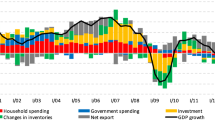Abstract
The hypothesis of the S-curve concept demonstrates that the correlation between past values of the trade balance and the current exchange rate could be negative, there may also be a positive association between future values of the trade balance and the current exchange rate. Previous studies focusing on the empirical S-curve were thought to have an aggregation bias since they assumed that both appreciation and depreciation have symmetry in cross-correlation with both the current and future value of trade balance. The current study explores the asymmetric S-curve between Pakistan and Japan at the commodities level. Using the S-curve concept, this study classified real exchange rates into two components (appreciation and depreciation) and attempted to determine whether the response of exchange rate movement is symmetric or asymmetric on the trade balance. The findings come up with significant support in favor of the "asymmetric S-curve" in eleven, out of fifteen industries. The findings are crucial in analyzing the behavior of the exchange rate appreciation and deprecation with the past and future values of trade balance at the industry level.
Similar content being viewed by others
References
Anju, G.-K., & Uma, R. (1999). Is there a J-curve? A new estimation for Japan. International Economic Journal, 13(4), 71–79.
Backus, K. and K. (1994). dynamics of trade balance and the terms of trade: the S-cutve. In NBER Working Paper (Issue 4242).
Bahmani-Oskooee, M. (1985). Devaluation and the J-curve: Some evidence from LDCs Author ( s) Mohsen Bahmani-Oskooee Source. The Review of Economics and Statistics, 67(3), 500–504.
Bahmani-Oskooee, M., & Goswami, G. G. (2004). Exchange rate sensitivity of Japan’s bilateral trade flows. Japan and the World Economy, 16(1), 1–15.
Bahmani-Oskooee, M., & Ratha, A. (2004). The J-curve: A literature review. Applied Economics, 36(13), 1377–1398.
Bahmani-Oskooee, M., & Ratha, A. (2010). S-Curve dynamics of trade between U.S and China. China Economic Review, 21(2), 212–223.
Bahmani-Oskooee, M., Usman, A., & Ullah, S. (2020). Asymmetric J-curve in the commodity trade between Pakistan and United States: Evidence from 41 industries. Eurasian Economic Review, 10(2), 163–188.
Demirden, T., & Pastine, I. (1995). Flexible exchange rates and the J-curve: An alternative approach. Economics Letters, 48(3–4), 373–377.
Hurley, D. T., & Papanikolaou, N. (2018). An investigation of China-U.S bilateral trade and exchange rate changes using the autoregressive distributed lag model. Economic Papers, 37(2), 162–179.
Junz, H. B., & Rhomberg, R. R. (1973). Linked references are available on JSTOR for this article. Price Competitiveness in Export Trade Among Industrial Countries, 63(2), 412–418.
Khatoon, R., Hasan, M. E., Ibon, M. W. F., Islam, S., Mehareen, J., Murshed, R., Pabon, M. N. F., Rahman, M. J., & Shuchi, M. S. (2021). Aggregation, asymmetry, and common factors for Bangladesh’s exchange rate–trade balance relation. Empirical Economics, 62(6), 2739–2770.
Korkmaz, A., & Bilman, M. E. (2017). The S-curve behaviour of the trade balance: A Stepwise Procedure. Foreign Trade Review, 52(1), 1–14. https://doi.org/10.1177/0015732516650826
Krueger, A. O. (1983). Exchange-rate determination. Cambridge University Press.
Krugman, P. R., Baldwin, R. E., Bosworth, B., & Hooper, P. (1987). The persistence of the US trade deficit. Brookings Papers on Economic Activity, 1987(1), 1–55.
Lal, A. K., & Lowinger, T. C. (2002). The J-curve: evidence from East Asia. Journal of Economic Integration, 17, 397–415.
Magee, S. P. (1973). Currency Con tracts, Pass-through, and. Brookings Papers on Economic Activity, 1973(1), 303–325.
Magee, S. P. (1973). Currency contracts, pass-through, and devaluation. Brookings Papers on Economic Activity, 1973(1), 303–325.
Parikh, A., & Shibata, M. (2004). Dynamics of the relationship between the terms of trade and the trade balance in developing countries of Asia, Africa and Latin America. Journal of Quantitative Economics, 2(2), 104–121.
Rose, A. K., & Yellen, J. L. (1989). Is there a J-curve? Journal of Monetary Economics, 24(1), 53–68.
Senhadji, A. S. (1998). Dynamics of the trade balance and the terms of trade in LDCs: The S-curve. Journal of International Economics, 46(1), 105–131.
Tomić, D. (2019). Empirical evidence of an S-curve in Croatia. Economic Research-Ekonomska Istrazivanja, 32(1), 2212–2230.
Upadhyaya, K. P., Mixon, F. G., & Bhandari, R. (2022). Is there a J-curve in China-U.S trade? International Journal of Finance and Economics, 27(1), 61–67.
Wilson, P., & Tat, K. C. (2001). Exchange rates and the trade balance: The case of Singapore 1970 to 1996. Journal of Asian Economics, 12(1), 47–63.
Funding
The authors of this paper claim that they have no funding.
Author information
Authors and Affiliations
Corresponding author
Ethics declarations
Conflict of interest
No conflicts of interest or no competing interests related to this article.
Rights and permissions
Springer Nature or its licensor (e.g. a society or other partner) holds exclusive rights to this article under a publishing agreement with the author(s) or other rightsholder(s); author self-archiving of the accepted manuscript version of this article is solely governed by the terms of such publishing agreement and applicable law.
About this article
Cite this article
Ahmad, S., Iqbal, J., Nosheen, M. et al. Dynamics of the asymmetric S-curve between Pakistan and Japan. IJEPS 17, 551–561 (2023). https://doi.org/10.1007/s42495-023-00112-0
Received:
Accepted:
Published:
Issue Date:
DOI: https://doi.org/10.1007/s42495-023-00112-0




